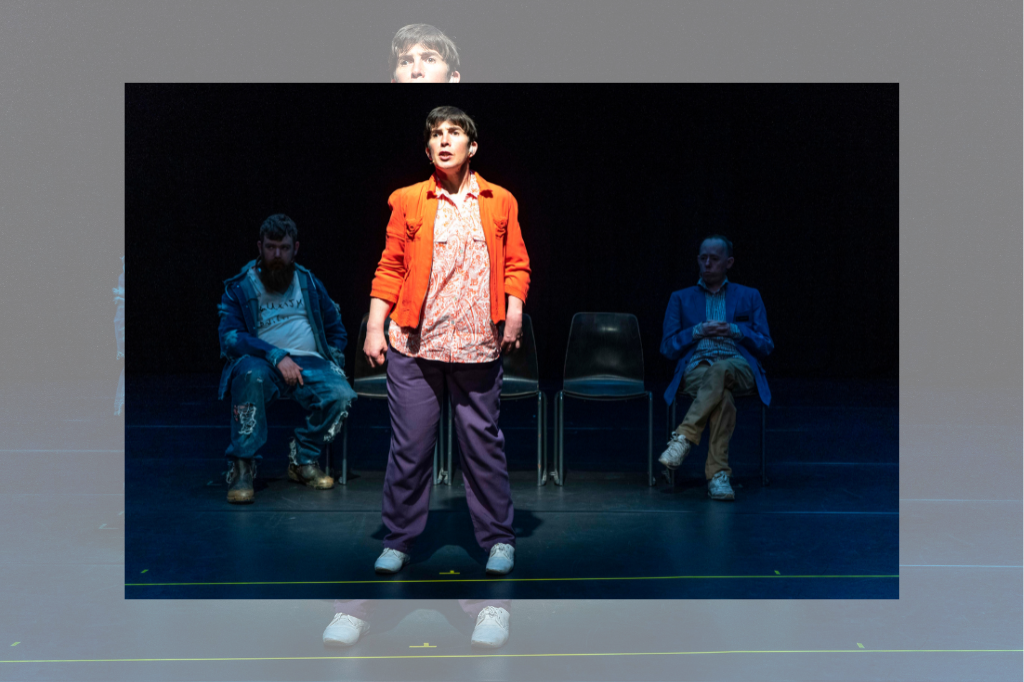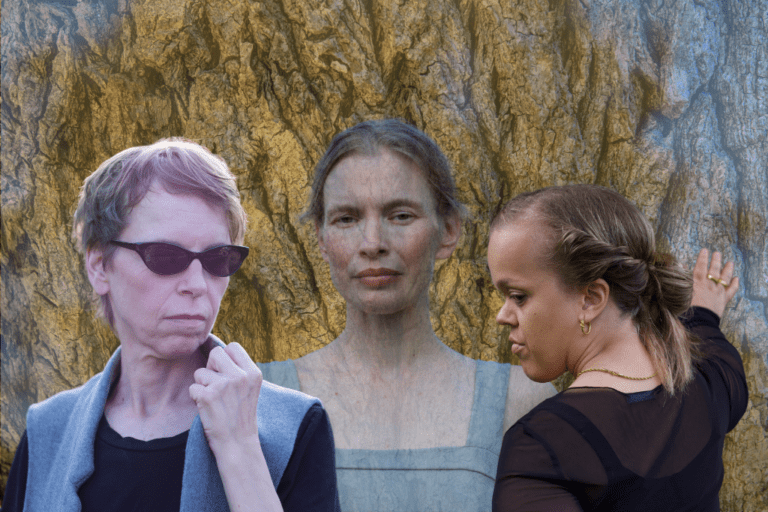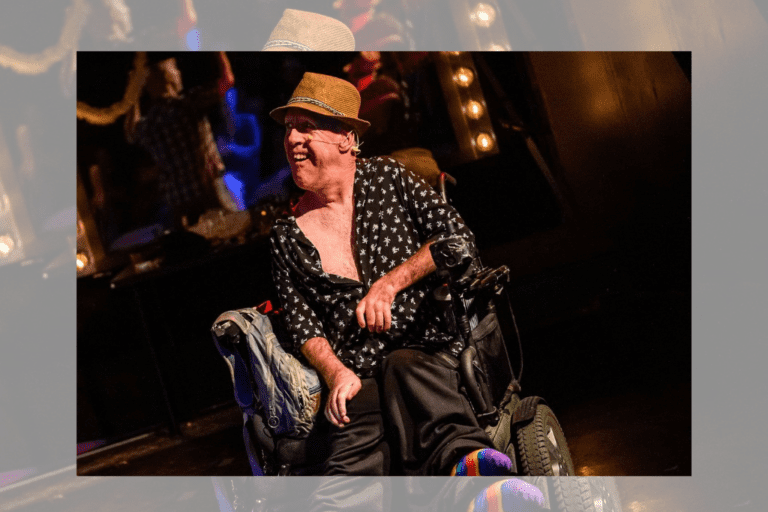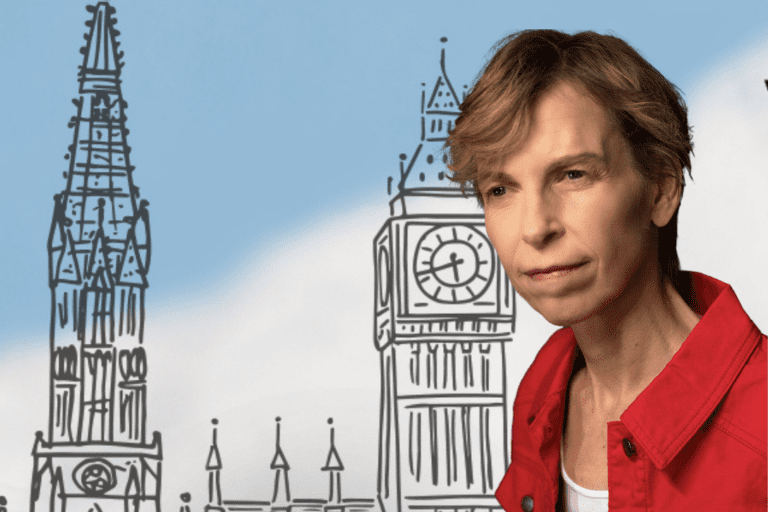REVIEW: The Shadow Whose Prey the Hunter Becomes is a Trojan Horse of disability theatre
On the surface, The Shadow Whose Prey the Hunter Becomes (a Back to Back Theatre production on stage at Canadian Stage’s Berkeley Street Theatre through January 28) presents a sobering question about the integration of AI into our day-to-day lives: In a world where neural networks can spit out entire paragraphs at a speed faster than we can say a single sentence, will all of us, regardless of how our brains work, someday be considered to have an intellectual disability relative to the computers we work with?
But that conceit is a clever red herring. At its core, Shadow is less about the threat of AI and more about how deeply ableism affects us all — even those of us who are not disabled. This smartly constructed experience has much to offer, both to those who have never considered disability and those who are further along in their understanding of disability justice alike.
To be sure, technology looms large in the piece from beginning to end. Out of an inky blackness a cursor emerges to illuminate the beginning of the show; a large caption screen hangs over the set throughout the piece. The cursor blinks and transcribes the words of Sarah, Simon, and Scott (Sarah Mainwaring, Simon Laherty, and Scott Price, who co-wrote the piece with their collaborators in the Back to Back ensemble — each play characters who share their real-life names) as they speak.
The surtitles, we learn, are part of an omnipresent AI device, using voice recognition to make Sarah, Simon, and Scott’s speech as neurodiverse people more comprehensible to a neurotypical audience.
Sarah, Simon, and Scott have gathered us, the audience, for a community meeting to help us understand the potential consequences if we do not develop a community where each of us is valued for more than our output and more than how quickly we can produce it. These three are metaphorical Cassandras, shining light on their present reality and what might await neurotypical people — including having “poor employment prospects.”
Director Bruce Gladwin’s production employs a workhorse, spartan set that evokes a community centre multi-purpose room with inventive theatrical conventions peppered throughout. From the set of four folding chairs (two of which are always left empty), to the oversized fluorescent lamps that hang overhead, to a large foam block that appears midway through the piece to stand in for both a podium and a bench in another room entirely, the actors appear small relative to the landmarks around them.
This sense of scale and relationship underscores the way nondisabled and neurotypical people underestimate and talk down to disabled people, and particularly those with intellectual disabilities. Watching this piece as a disabled artist and seeing how diminutive each of the actors appeared against the negative space in this set design brought to mind the familiar feeling of being under a microscope — because when you are visibly disabled, everyone is always staring at you.
Shadow is particularly impressive in the way it manages to introduce the realities of ableism to audience members who have no background in disability, while simultaneously digging deep into more complex concepts for those who spend time regularly thinking about disability. For those who are ready to move beyond a basic introduction, Shadow has much to say about the hierarchy of disability, the labels and language of disability, and the right to self-identification, sexual politics, and internalized ableism.
I was particularly struck by a moment of Simon’s, when he shares that he sometimes “[feels] ashamed for feeling ashamed” of being disabled — a sentiment that could have been pulled out of my own conversations with fellow disabled people, and an investigation of the complex double-bind in which many disabled people find themselves: a need to push back against the stereotype that being disabled is the worst thing that can happen to you, but also trying to find space to hold the reality that being disabled can be extraordinarily challenging. Before Shadow, I don’t know if I’d ever seen a piece of theatre that engaged with a high-level disability politics concept like What do I do if I feel I can’t be honest about my lived experience without also feeling like I’m letting my community down?
This piece’s Trojan Horse construction is deft, and a convention I wish we would see more of in Toronto theatre. Statistics Canada data from 2022 shows that 27 per cent of Canadians aged 15 or older live with at least one disability. However, Toronto theatre has not proportionally reflected that incidence of disability, either in the plays produced or the ways plays are cast. Disability theatre was once considered to be a niche genre, but plays like Shadow remind us that there is exciting artistic ground to be mined for all audiences, especially if we can use subversive structures like the one Shadow employs to take the audience on a ride past Disability 101 and on to more provocative subjects.
It is also not lost on me that Shadow is touring from Australia. As a disabled artist myself, it is a joy to witness a Back to Back production in person and be reminded of the strength of the global disability arts movement. However, as I watched Sarah (who walks with a gait deviation due to her head injury), I felt a pang of recognition — here is someone who walks something like the way I do as a physically disabled person! — and also a pang of questioning — what will it take to see Canadian disabled artists who walk the way I do walk across Toronto stages?
Does it take international acclaim to get onto a Toronto stage as a disabled artist? If anything, Shadow underscores that it shouldn’t. Though Shadow had its world premiere pre-COVID-19, it is impossible to divorce this piece from our present context, a world where the pandemic has not ended and the risk of developing long COVID increases with every COVID infection. Every day, all around us, people are becoming disabled in greater and greater numbers.
Therefore, the questions Shadow poses about disability are real and urgent: What will we do if we all become disabled? How will we care for one another? In my opinion, part of that care should include making art that centres disabled people, so our growing disabled population can see their experiences reflected.
Shadow is must-see theatre, with its quiet but insistent interrogation of complicated subjects, and I hope it is the start of a deeper investment in disability by the Toronto theatre community.
The Shadow Whose Prey the Hunter Becomes runs at Canadian Stage until January 28. Tickets are available here.
Intermission reviews are independent and unrelated to Intermission’s partnered content. Learn more about Intermission’s partnership model here.













Comments